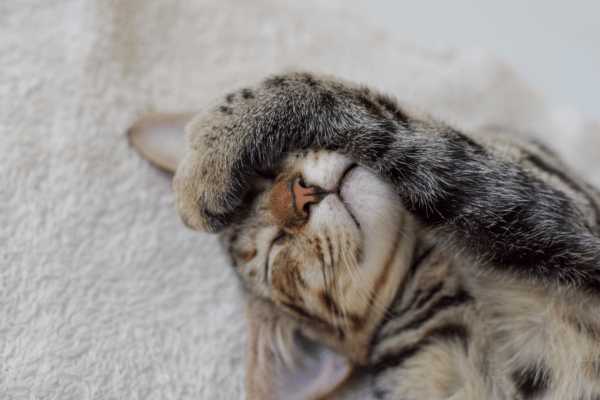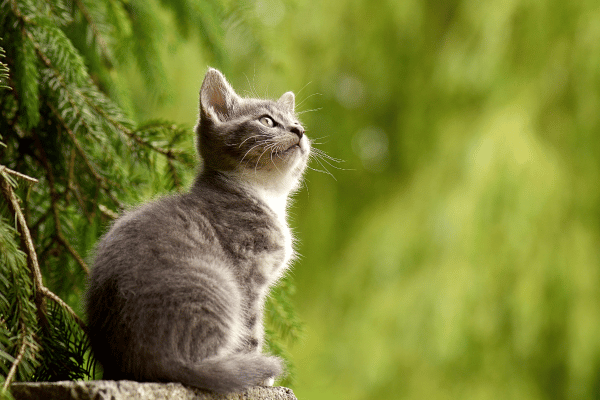Understanding adolescent cat behavior is crucial for pet owners. This article delves into the nuances of your growing cat’s changing demeanor, offering essential guidance and advice.
Recognizing Changes in Your Adolescent Cat

Adolescence in cats, typically occurring between six and eighteen months, marks a significant transition. During this phase, your feline friend undergoes considerable behavioral changes. It’s a period characterized by increased curiosity and independence. Understanding these shifts is vital. As a seasoned pet caretaker, I’ve observed that adolescent cats often exhibit more exploratory and assertive behaviors. This stage requires patience and a deep understanding of feline psychology to navigate successfully.
This life stage also brings about new challenges in training and socialization. Adolescent cats may test boundaries, displaying behaviors like scratching or ignoring commands. However, this is also a time for strengthening bonds. Consistent, gentle training and positive reinforcement are key. Additionally, environmental enrichment is crucial. Providing stimulating toys and safe outdoor experiences can significantly benefit their development. Remember, each cat is unique, and their personality greatly influences their behavior during adolescence.
Moreover, adolescent cats require specific nutritional care to support their growth. Consulting with a “cat friendly” veterinarian can ensure their dietary needs are met. Regular vet visits are essential during this stage for health monitoring and vaccinations. Also, be mindful of their social needs. Introducing them to new environments and other pets should be done gradually. With proper care and understanding, navigating your cat’s adolescence can be a rewarding and enriching experience.
Effective Strategies for Behavioral Management
Managing behavioral changes in adolescent cats requires a blend of patience and strategy. It’s important to establish a routine that includes playtime, feeding, and rest. Consistency in these routines provides a sense of security for your cat. During play, engage in activities that stimulate their hunting instincts, like chasing toys. This not only entertains them but also helps expend their abundant energy, reducing potential mischievous behavior. Remember, patience is key during this developmental stage.
Socialization plays a crucial role in an adolescent cat’s life. Introduce them to various stimuli like different sounds, people, and other pets in a controlled manner. This exposure helps in developing a well-adjusted adult cat. However, it’s essential to monitor their reactions and proceed at a pace they are comfortable with. Overwhelming them can lead to stress and fear. Positive reinforcement, such as treats and praises, effectively encourages desirable behavior during these interactions.
Lastly, addressing their need for independence is crucial. Adolescent cats often seek more alone time and may become more territorial. Providing them with their own space, like a cozy bed or a perch with a view, can be very beneficial. Also, be attentive to any sudden behavioral changes, as they could indicate health issues. Regular veterinary check-ups are imperative to ensure their well-being. Understanding and respecting their evolving needs fosters a harmonious coexistence.
Adolescent Cat Behavior: Adapting to Changes
Adapting to your cat’s adolescent behavior can be challenging yet rewarding. During this phase, they may exhibit increased territorial instincts. Marking territory, either through scratching or spraying, is common. To mitigate this, provide ample scratching posts and maintain a clean litter box. Also, consider spaying or neutering, as it can significantly reduce such behaviors. Understanding these natural instincts is crucial. Remember, these behaviors are a part of their developmental process and not a defiance against authority.
Another aspect of adolescent cat behavior is fluctuating energy levels. You might notice your cat displaying bursts of energy, followed by periods of rest. Engage them with interactive toys to channel this energy positively. Puzzle feeders are also excellent for mental stimulation. It’s essential to balance playtime with relaxation to prevent overstimulation. Creating a safe and stimulating environment caters to their physical and mental needs, promoting overall well-being.
Communication is key during this stage. Pay attention to their body language and vocalizations, as these are indicators of their emotional state. A tail flick or a certain meow can convey much about their feelings. Responding appropriately to these signals strengthens your bond. Regular grooming sessions also provide an opportunity for physical contact and bonding. Remember, patience and understanding go a long way in nurturing a healthy relationship with your adolescent cat.
Balancing Affection and Independence in Adolescence
During adolescence, cats often display a delicate balance between seeking affection and asserting independence. You might find your cat craving attention one moment and preferring solitude the next. It’s important to respect their space while remaining available for interaction. Creating a nurturing environment where they feel safe to come and go as they please is key. This respect for their autonomy fosters trust, an essential element in the bond between you and your cat.
In this stage, it’s also vital to monitor and adapt to their changing preferences in play and companionship. Some cats may develop a preference for certain types of toys or games. Observing and adapting to these preferences can enhance your interactions. Additionally, if you have other pets, supervise their interactions to ensure they are positive and non-threatening. Proper socialization during adolescence lays the foundation for harmonious relationships with other animals in the future.
Lastly, remember that each cat is an individual with its own personality and needs. What works for one may not work for another. Be observant and responsive to your cat’s unique behaviors and preferences. Regular check-ins with a veterinarian, especially one with a “cat friendly” approach, can provide valuable insights into your cat’s health and well-being. Tailoring your approach to your cat’s individuality will help you navigate their adolescence with understanding and compassion.
Enhancing Environment for Your Adolescent Cat
Creating an enriching environment is crucial for adolescent cats. This stage is filled with exploration and learning. Provide various stimuli like climbing trees, hiding spots, and window perches. These not only cater to their natural instincts but also prevent boredom and potential behavioral issues. An engaging environment stimulates their mind and body, promoting healthy development. Additionally, ensure that their living space is safe and free from hazards that could harm a curious and energetic adolescent cat.
Interactive play is another essential aspect of their environment. Regular play sessions using toys that mimic prey, like feather wands or laser pointers, can satisfy their hunting instincts. This not only strengthens your bond but also aids in their physical and mental development. Remember to rotate toys to maintain their interest. Also, consider puzzle toys that challenge them and reward their problem-solving skills, which are crucial for their cognitive development.
Lastly, consider the importance of a routine in your adolescent cat’s life. Consistent feeding, play, and rest times provide a sense of security and structure. This predictability helps them feel more in control of their environment, reducing stress and anxiety. Regular grooming and check-ups should also be part of their routine. An environment that balances stimulation with predictability is key to nurturing a well-adjusted and happy adolescent cat.
Addressing Behavioral Issues in Adolescent Cats

Behavioral issues can be prominent in adolescent cats. It’s not uncommon for them to exhibit unwanted behaviors like biting or scratching. Understanding the root cause is essential. Often, these actions are ways to communicate or a response to unmet needs. Ensure they have enough physical activity and mental stimulation. Ignoring these needs can lead to frustration, manifesting in undesirable behaviors. Addressing these issues early with patience and consistency is crucial for long-term behavior management.
Training plays a significant role in managing these behaviors. Utilize positive reinforcement techniques, rewarding good behavior with treats or affection. Avoid punishment, as it can lead to fear and mistrust. Instead, redirect negative behaviors towards acceptable outlets. For instance, if your cat scratches furniture, provide them with appropriate scratching posts. Consistent training and positive reinforcement can effectively reshape their behavior, making this transitional phase smoother for both you and your cat.
Additionally, environmental stressors can contribute to behavioral issues. Changes in the household, like new pets or moving furniture, can unsettle your cat. Provide a safe, quiet space where they can retreat when overwhelmed. Using pheromone diffusers can also help in creating a calming environment. Remember, patience and understanding are key. Each cat is unique, and what works for one might not work for another. Tailoring your approach to your cat’s specific needs is essential.
Fostering Health and Wellness in Adolescence
Adolescence in cats is not just about behavioral changes; it’s also a critical time for their physical health. Regular veterinary check-ups are essential to monitor their development and address any health concerns promptly. This stage often involves vaccinations and discussions about spaying or neutering, which can impact their behavior and overall health. A balanced diet tailored to their age and activity level is crucial for supporting their growth and maintaining optimal health during this transformative period.
Exercise is equally important for adolescent cats. Engaging in daily play sessions helps maintain a healthy weight and prevents obesity, a common issue in domestic cats. These activities also strengthen their muscles and improve coordination, vital for their physical development. Additionally, mental exercise through interactive toys and training challenges their cognitive abilities, promoting mental health. Balancing physical and mental stimulation is key to fostering a well-rounded and healthy adolescent cat.
Lastly, don’t overlook the importance of emotional well-being. Cats are sensitive creatures, and their emotional health significantly impacts their overall wellness. Providing a loving, stable environment with consistent routines helps reduce stress and anxiety. Regular affection and bonding time are essential, as they reinforce your connection and provide emotional security. Understanding and catering to your cat’s emotional needs during adolescence lays the foundation for a well-adjusted and happy adult cat.
Adolescent Cat Behavior: Building Lasting Bonds
Building a lasting bond with your adolescent cat is a journey filled with learning and adaptation. This stage is an ideal time to deepen your connection. Spend quality time together, engaging in activities your cat enjoys. This could be interactive play, gentle petting, or simply sitting together. Understanding and responding to their communication cues, like purring or meowing, enhances this bond. Remember, the effort you put into this relationship now will shape the bond you share in the future.
Consistency in your interactions is key. Regular feeding, playtime, and grooming sessions establish a routine that your cat can rely on. This consistency not only builds trust but also provides a sense of security for your cat. Be mindful of their moods and preferences, as they can change during adolescence. Adapting to these changes shows your cat that you respect and understand them, further strengthening your bond.
Lastly, remember that bonding with your cat is a two-way street. Pay attention to what they enjoy and what they avoid. Some cats may love being held, while others prefer sitting beside you. Respecting their boundaries and preferences is crucial. This mutual understanding and respect form the foundation of a strong, lasting relationship. With patience, love, and understanding, you can build a deep, enduring bond with your adolescent cat.
Preparing for Adulthood: Key Considerations
As your cat transitions from adolescence to adulthood, preparation is key. This period lays the groundwork for their adult life. It’s important to gradually shift their diet to one suitable for adult cats, ensuring it meets their nutritional needs. Also, consider their long-term health by maintaining a schedule of regular veterinary check-ups. These visits are crucial for early detection and prevention of potential health issues that could arise as they mature.
Behavioral training and socialization should continue to be a focus. Reinforcing positive behaviors and gently correcting undesirable ones help in establishing good habits that will carry into their adult years. This is also a time to solidify routines established during adolescence, such as feeding times, play sessions, and grooming. Consistency in these routines helps your cat feel secure and reduces anxiety, contributing to a well-adjusted adult cat.
Finally, consider the emotional aspect of your cat’s development. Continue to nurture the bond you’ve built, as it will be a source of comfort and security for them throughout their life. Be attentive to any changes in behavior, as these can indicate underlying issues. Remember, the transition to adulthood is a gradual process. Patience, understanding, and consistent care will ensure your cat grows into a healthy, happy, and well-adjusted adult.
Cultivating Lifelong Health in Your Cat
Cultivating lifelong health in your cat begins in adolescence. This stage is crucial for setting the foundation for a healthy future. Regular exercise and a balanced diet are key components. Ensure your cat gets enough physical activity to prevent obesity and maintain muscle tone. A diet rich in essential nutrients supports their overall health and vitality. Also, be proactive about dental care, as good oral health is vital for preventing future issues.
Mental health is equally important. Stimulating your cat’s mind through interactive play and new experiences prevents boredom and stress. Toys that mimic natural behaviors, like hunting, are excellent for mental stimulation. Additionally, provide opportunities for your cat to explore safely, whether it’s a secured outdoor space or new areas within your home. Keeping their environment engaging and stimulating promotes mental well-being, essential for a happy and healthy life.
Lastly, regular veterinary care is essential. Routine check-ups, vaccinations, and preventive treatments are crucial for early detection and management of health issues. Discuss with your vet about any concerns and follow their recommendations for care. Remember, your cat’s health is a lifelong commitment. By providing consistent care, attention, and love, you can ensure your cat enjoys a long, healthy, and fulfilling life.
In Summary
In conclusion, navigating your cat’s adolescence is a journey filled with challenges and rewards. Emphasizing consistent care, understanding behavioral changes, and fostering a nurturing environment are key. Remember, the habits and routines established during this time lay the groundwork for their adult life. Regular interaction, play, and affection are not just beneficial for their physical health, but also for their emotional well-being, solidifying the bond between you and your cat.
Adolescence is a critical period for developing lifelong health habits. Balanced nutrition, adequate exercise, and mental stimulation are essential. Regular veterinary check-ups play a vital role in maintaining their health. According to the American Veterinary Medical Association (AVMA), early detection of health issues through routine visits can significantly impact your cat’s long-term health. Visit AVMA’s website for more insights on pet health.
Encourage readers to embrace this special time with their cats. Each moment is an opportunity to strengthen your bond and understand your pet better. If you found this article helpful, consider exploring more on our blog or sharing your experiences in the comments. Your insights could help other pet owners navigate this fascinating stage of their cat’s life.
III. Frequently asked questions about pet life stages
- Is it safe to feed dog food to a cat or vice versa?It is not recommended to feed dog food to a cat or vice versa, as each type of food is formulated to meet the specific nutritional needs of each species.
- How can you calculate a dog or cat's "human age"?A dog or cat's "human age" can be calculated using specific formulas that consider the pet's size and actual age, but these formulas are only estimates.
- What are the benefits of genetic testing for pets?Genetic testing can offer insights into disease predisposition, breed characteristics, and guide the most appropriate care and management for the pet's health.
- How can you identify and prevent joint diseases in pets?Joint diseases can be identified by signs such as movement difficulty, pain when touched on the joints, and reluctance to jump or play. Prevention includes maintaining an ideal weight, regular exercise, and supplementation if necessary.
- How has the life expectancy of pets changed in recent decades?The life expectancy of pets has increased due to advancements in veterinary medicine, nutrition, and greater awareness of preventive care and animal welfare.
- What veterinary tips are essential for feeding pets at each life stage?Tips include providing a balanced diet suitable for the life stage, considering special health needs, and adjusting portions to prevent overweight.
- How can proper nutrition influence the effectiveness of vaccines in puppies?Balanced and nutrient-rich nutrition can strengthen the immune system of puppies, enhancing their response to vaccines.
- How can you determine a cat's age in human years?A cat's age in human years can be estimated by considering that the first two years correspond to about 24 human years, with each subsequent year equating to approximately four human years.
- What are the signs that your dog is aging?Signs include decreased energy, the appearance of white hair, movement difficulty, behavioral changes, and possible age-related health issues.
- What is the ideal toy for each stage of a dog's life?Puppies may benefit from teething toys, adult dogs may need durable chewing toys and interactive toys for mental stimulation, and senior dogs may prefer softer, easy-to-handle toys.
- Toggle TitleToggle Content

Join Dan Morgan at dwfocus.com, your hub for ‘4 paws and owners’ wisdom! Explore a world where pet care meets expert insights, crafted by Dan, a seasoned vet with a heart for animals. Engage with stories, tips, and advice that every pet owner needs. From playful pups to graceful cats, Dan Morgan guides you through the joys and challenges of pet parenting. Embrace your love for pets with Dan’s expert guidance on dwfocus.com. #4PawsAndOwners #DanMorganPetExpert #dwfocus







